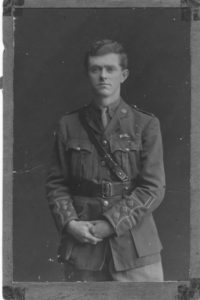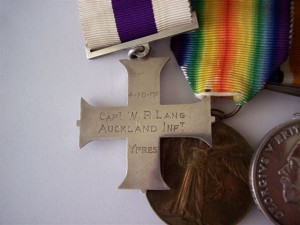
On Anzac Day, it seems a good time to remember one of the soldiers in my family – my grandfather. He was lucky – he came back, and had five children and lived a long life after the war, even though he was wounded. I never met him, as he died when I was three. But I’ve seen some of the (quite dangerous) souvenirs he brought back from the war, and heard stories about him all my life.
When I was growing up in Australia, most of my peers had some relative or other who served in WWI. Not so true these days, as more of our immigration comes from countries that weren’t big participants. Or else, like other parts of the Eye family, from countries that were on the other side from Australia. Nevertheless, it was such a carnage, and so many people died, that it is worth remembering, and commemorating, as a reason why war should always be thought of as a last resort in conflict resolution.
My grandfather was born in 1890, and left school at 12, when his father died, to run the family farm. When war broke out, in 1914, he was already a member of a volunteer unit of the NZ army. Lots of people made the transition to expeditionary soldier swiftly. Grandpa ran into resistance when he tried to organise the farm for his absence. Several relatives tried to talk him out of it. So he wasn’t one of the early volunteers who were at Gallipoli a hundred years ago.
It took a year (and reportedly the receipt of at least one anonymous white feather in the mail) before he was set to sail in December 1915. In that interim he had gone from being a senior non-commissioned officer to being a second, one ‘pip’, lieutenant. A hiccup of some sort kept the convoy in port until 1 January 16. They sailed to Egypt and stuck around there for a while and then were sent on to France. My dad never discussed Grandpa’s actual movements with him. He did once remark that his first crowd of warriors did things with trench mortars and he thought they were all crazy. They tended to investigate unexploded weaponry.
In the summer of 1916 Grandpa spent time at the Somme (a byword for waste of life on both sides). During that time that he went up a grade to first lieutenant entitled to wear two pips. Most of his fighting was in Belgium, in Flanders.
He spent most of 1916 in Belgium, which was the “quiet time” on that part of the Western Front. When we visited, our guide pointed out to us that “quiet time” just meant that fewer people were dying every week, instead of the carnage of the big battles (5,000 in one night), there were a few hundred a week.
In 1917, the Allies decided to try and push to the coast of Belgium. The first step was at Messines, in June, when after a year of tunnelling, the Allies exploded around 20 bombs directly under the German front line and killed 10,000 Germans in one go, and managed to get a few kilometres forward that day. The second step, though, is known as Passchandaele, and is almost as notorious as the Somme for the waste of human life. The whole campaign was to try and dislodge the Germans from their entrenched positions on the Passchandaele ridge. Not much of a ridge today, but in a flat country like Belgium, enough to make an enormous strategic difference.
The Allies spent three months fighting uphill through thick mud, with many soldiers dying from falling off their duckboards and drowning before they could get up again. The main battle for the New Zealand troops was Broodseinde, in which Grandpa won a Military Cross.
In the military history for the New Zealanders, there is a map. Two lines of dashes curve down the map. On the left the label “German Front Line (3rd. Oct., 1917)”. Now move to the right something like two kilometres, but not uniformly. The second label says, “New Zealand Line (4th. Oct, 1917)”. A lot of blood flowed between those times and places.
There are spots on the map with names. Two that matter are Winzig and Aviatik Farm, between two and three hundred metres behind the marked German front line.. All the place names hint at history – usually recent and transported history. Winnipeg, Gallipoli, Abraham Heights, Berlin, Berlin Wood, Albatross Farm, Calgarry Grange, Waterloo, Kansas House, Kansas Cross and Peter Pan are on this map. The two New Zealand companies were the 3rd Auckland Company, commanded by Captain Coates (later Prime Minister of New Zealand), and 15th North Auckland, including Grandpa. In the lead up (3/10/17) the battalion “were lying very close to the enemy strong points at Winzig and Aviatik Farm, from whence came a considerable volume of machine gun fire,….” They were said to be in “Cluster Houses”, about 200 metres into the “friendly” area.
It was later established that the other side was planning an attack on the morning of the 4th. There were two waves of the Auckland Regiment each of about 170 men set to attack about 400 Germans. The British artillery opened up at 6.00AM, about ten minutes before the German zero hour, and about a quarter hour before dawn.There was a quagmire approximately at that ‘German Front Line’ There were narrow and winding tracks which the Germans appeared to have accurately targetted. Those 170 men were somehow spread over about 500 metres and also combined with another company, between the two marked strong points.- and concentrated toward Winzig. Both companies combined to take Winzig.
In the action once joined the narrative condenses. In five sentences on four lines the attack lost three officers. Two lines further down “Lieutenant Lang and his platoon were within bombing range.” …Four strenuous lines later … “…Winzig fell. The advance was at once continued under the direction of Captain Coates.” There were further objectives, and flanks to protect. I gather they eventually dug in “on the further side of our own barrage”.

My Grandpa won a Military Cross that day. His citation said
Awarded military cross for acts of gallantry in the field (NZEFOs 419)
(HQrs Lon 31.10.17)
Awarded MC for conspicuous gallantry and devotion to duty. He took command of his Coy in an attack, when he was the only surviving officer, and captured his objectives with great skill & courage. He showed a quick grasp of the situation & complete disregard of danger. {NZEFOs 554 Hqrs Lon 15-4-18)
The description in the military history makes it sound organised, and planned, but with terrible loss of life. But it was mostly a disorganised, muddy, mess. By October that year, it had been raining constantly. Flanders is wet at the best of times, but early in the War, the Belgians had destroyed most of the drainage systems in a futile attempt to hurt the Germans. In the end, both sides spent months at a time in the mud, with a shell a minute being fired in their general direction, and the constant reminder of the mortality around them as it was next to impossible to retrieve the dead bodies from no mans land.
The ground won by the New Zealanders, which was a small part of the Passchandaele campaign, was ultimately ceded back to the Germans in early 1918, after the Allies realised they couldn’t hold it. But that small patch of a few kilometres of ground had taken around 500,000 casualties on both sides the year before.
Our family recently found a part of his diary – from 1918, so not covering the events I’ve described above. But my favourite entry is related, almost exactly a year later:
Up. Shine up like a shilling. Push down to Buckingham Palace receive M.C.

Hi Jennifer
Thanks for your very personal post. It’s stories like your one (and the many others we have been seeing on TV and hearing on the radio) that humanise what can otherwise just be startling statistics about Australia’s and New Zealand’s involvements in the Great War. They help make Anzac Day live more vividly for us all 100 years on.
Ian
Jennfier, great story from your family. My Great Em arrived as a reinforcement at Gallipoli in May and was evacuated minus a left eye a short time latter. The injury was from shell fire, most likely from allied warships off shore as the Turks had scant artillery at that stage. Our family mystery was that he taken to hospital in the UK, but did not return to Australia till 1919? My brother suggested there was likely a English lass. He didn’t met Great Aunt until he returned, so no scandal. Another mate said the infirmed were often kept on as hospital orderlies. He too lived to a ripe old age and raised a family. Oddly, he was probably fortunate to have been injured at Gallipoli. When the troops were redeployed to France they experienced 1 in 10 shells being gas. Those who survived the War had their health wreaked and very few lived beyond their 50s. My former partners grandfather and great uncle had been city boys when the enlisted, but when the returned were offered soldier settlements – hard scrabble land that the scatters hadn’t wanted. This was the thanks of a grateful nation and how her family ended up in Gippsland. They walk off the land and took town jobs in the 20s. There must be endless analyses awaiting for an Actuarial to throw their Eye. I reckon it is easier to have solemn remembrance when the survivors are dead.